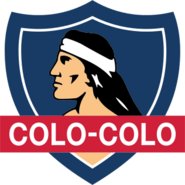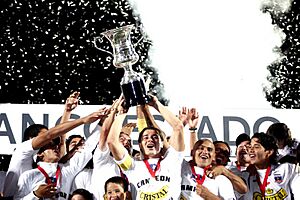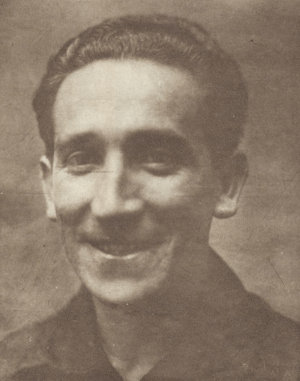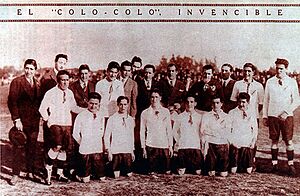Colo-Colo facts for kids
 |
|||
| Full name | Club Social y Deportivo Colo-Colo | ||
|---|---|---|---|
| Nickname(s) | El Cacique Eterno Campeón (The Eternal Champion) Los Albos (The Whites) |
||
| Founded | 19 April 1925 | ||
| Ground | Estadio Monumental David Arellano, Macul, Greater Santiago |
||
| Capacity | 47,347 | ||
| President | Aníbal Mosa (Blanco y Negro) Matías Camacho (Corporation) |
||
| Manager | Daniel Morón | ||
| Coach | Jorge Almirón | ||
| League | Chilean Primera División | ||
| 2024 | Primera División, 1st of 16 | ||
|
|
|||
Colo-Colo, officially called Club Social y Deportivo Colo-Colo, is a famous football club from Chile. It was started in 1925 by David Arellano in Macul, Santiago. The team plays in the Chilean Primera División, which is the top football league in Chile. Colo-Colo has never been moved down to a lower league, which is a big achievement! Since 1989, they have played their home games at Estadio Monumental David Arellano. Many people see Colo-Colo as the most successful football club in Chile.
Colo-Colo has won the Primera División de Chile title 34 times. This is more than any other Chilean club. They have also won the Copa Chile a record fourteen times. In 1991, they became the first Chilean team to win a big international tournament, the 1991 Copa Libertadores. The next year, they won two more international titles: the 1992 Recopa Sudamericana and the 1992 Copa Interamericana.
The player who has scored the most goals for the club is Carlos Caszely with 208 goals. The player with the most games played is Lizardo Garrido, who played 560 matches. Luis Mena, known as "the historic one," won eleven titles with the club. This is a record in the Chilean league.
Colo-Colo is the most popular team in Chile. In 2016, CONMEBOL said they had over 7 million fans. Colo-Colo has a big rivalry with Universidad de Chile. They also have rivalries with Cobreloa and Universidad Católica. The IFFHS (International Federation of Football History & Statistics) ranked them as the top club in Chile for the 20th century. They were also named one of the top twenty clubs in South American football history.
Contents
Club History
How Colo-Colo Started (1925–1933)
Colo-Colo was started in early 1925. A group of young players, led by David Arellano, left their old club, Magallanes, because of problems. After many meetings, on April 19, 1925, Arellano and the other players officially formed the new club. Luis Contreras chose the name "Colo-Colo." This name honors the brave cacique (chieftain) Colo Colo of the Mapuche people. He fought against the Spanish in the 1500s.
At first, the team played friendly games. In 1926, Colo-Colo joined their first competition, the Metropolitan League of Honour. They won it without losing any games, earning the nickname "invincible." The next year, Colo-Colo became the first Chilean football team to tour Europe. Sadly, on May 2, 1927, during a game in Valladolid, David Arellano was badly hurt. He died the next day. Even with this sad event, the club won the Central League of Football tournament in 1928, 1929, and 1930.
In 1931–32, Colo-Colo faced money problems. Player salaries were cut, which caused issues. That season, they played a final against Audax Italiano. However, a platform collapsed at the stadium, causing many injuries and three deaths. The game was stopped, and no champion was named for that year. Some say both teams were declared champions.
Joining Professional Football (1933–1973)
In 1933, Colo-Colo and six other clubs from Santiago decided to create Chile's first professional football league. On July 23, Colo-Colo won the Campeonato de Apertura (which was like an early Copa Chile). They beat Unión Española 2–1. In the first official Primera División tournament, Colo-Colo tied for first with Magallanes. They had to play a tie-breaker match, which they lost 2–1.
In 1937, the team won its first league title without losing a game. Two seasons later, in 1939, Colo-Colo won the league title again. This was under coach Francisco Platko from Hungary. Alfonso Domínguez was their top scorer with 20 goals. They won another title in 1941 with Platko. Then, they won titles in 1944 and 1947. In 1948, Colo-Colo hosted the South American Club Championship in Santiago. This tournament was a start for the Copa Libertadores. In 1945, the club had its worst season, finishing second to last.
In the early 1950s, the club's president, Antonio Labán, signed Newcastle United striker George Robledo. This cost £25,000. Robledo's great playing helped the team win titles in 1953 and 1956. During this time, the club bought land in Macul to build Estadio Monumental. They also bought a main office in downtown Santiago in 1953. In the next ten years, Colo-Colo won titles in 1960 and 1963. The 1963 team set two records: Luis Hernán Álvarez scored 37 goals in one season, and the team scored 130 goals in total. The team won its tenth title in 1970.
Colo-Colo's Success in the 1970s and 1980s
In 1972, with coach Luis Álamos and star players like Francisco Valdés and Carlos Caszely, the club won another championship. They also had the highest average fan attendance, with 45,929 people per game. This team formed the "Colo-Colo 73" side. They became the first Chilean team to reach a Copa Libertadores final, but they lost to Independiente from Argentina. After this great run, the club faced problems and didn't win another league title until 1979. That team had the talented Brazilian midfielder Severino Vasconcelos and Carlos Caszely, who had returned from playing in Spain. In 1975, the Estadio Monumental was finished and opened. However, it was closed soon after due to problems with its facilities.
In the 1980s, the club won league titles in 1981 and 1983 with coach Pedro García. They also won in 1986 and 1989 under Arturo Salah. In 1987, after the Alianza Lima air disaster killed many players, Colo-Colo was the first to help. They loaned 4 players to the Peruvian team. The team also won four Copa Chile titles in that decade. However, they didn't do as well in international competitions, only reaching the group stage of the 1988 Copa Libertadores. On September 30, 1989, the Estadio Monumental was officially reopened. Colo-Colo won an exhibition match against Peñarol 2–1.
International Triumphs (1991–1999)
The 1990s were the most successful years for the club. They won both national and international titles. Eduardo Menichetti was president from 1990–1995. Croatian coach Mirko Jozić joined the team. He led them to their first Bicampeonato (winning two national championships in a row). On June 5, 1991, Colo-Colo beat Olimpia 3–0 at the Monumental stadium. This made them the first Chilean team to win a Copa Libertadores. That same year, they lost the Intercontinental Cup final 3-0 to Red Star Belgrade in Tokyo. Locally, the club won the 1991 league season, their third title in a row, achieving their first Tricampeonato.
The next year, the club won the Recopa Sudamericana by beating Brazil's Cruzeiro in a penalty shootout. They also won the Copa Interamericana by beating Puebla 3–1 in Mexico. Jozić's last title with Colo-Colo was the 1993 league title. This ended a very successful time for him in South America.
After Jozić left, the team had a short period without winning national league titles. However, they had a memorable 3–0 win over their rivals, Universidad de Chile, in 1995. Colo-Colo won the Copa Chile in 1994 and reached the quarterfinals of the 1994 Copa Libertadores. The next season, Paraguayan coach Gustavo Benítez arrived. He won league titles in 1996, 1997-C, and 1998. The team reached the semifinals of the Supercopa Libertadores in 1996 and the Copa Libertadores in 1997. Both times, they were knocked out by Cruzeiro. In 1999, Colo-Colo had a tough year, finishing fourth in the league and changing coaches three times.
Bankruptcy and Comeback (1999–Present)
In 1999, after Benítez left, the club faced serious money problems. On January 23, 2002, after years of poor financial management, the club was declared bankrupt. A judge appointed Juan Carlos Saffie to manage the club and make sure it didn't lose its legal status. Even with bankruptcy, under coach Jaime Pizarro (a key player in the 1991 Copa Libertadores win), "Los Albos" won the Torneo de Clausura. This team was mostly made up of young players from their academy.
Three years later, in 2005, a company called Blanco y Negro took over the club's management. They bought all the club's assets for thirty years. In return, they agreed to pay off all the club's debts. In the first half of 2006, the court ended the bankruptcy.

In 2006, with Argentine coach Claudio Borghi and players like Matías Fernández and Humberto Suazo, Colo-Colo played amazing football. They won the Bicampeonato by winning both the Apertura and Clausura tournaments. The team also reached another international final, the Copa Sudamericana, but lost 2–1 to Mexico's Pachuca. That season, the IFFHS named Colo-Colo the world's club of the month in October. The next season, Colo-Colo won two more tournaments in a row, achieving a Tetracampeonato (winning four championships back-to-back). This was the first time a Chilean team had done this.
After Borghi left, the club won its 28th title. They beat Palestino in the 2008 Torneo de Clausura finals. This was under coach Marcelo Barticciotto, with Lucas Barrios as their top scorer. Barrios scored 37 goals, matching a club record. The next season, the club became the first professional team to play on Rapa Nui (Easter Island). After a difficult start to the 2009 Clausura season, "Los Albos" were near the relegation spots. However, they made a comeback and reached the play-off finals against Universidad Católica. They won 4–2 with players like Esteban Paredes, Macnelly Torres, and Ezequiel Miralles, coached by Hugo Tocalli. Colo-Colo's next championship was in 2014 when they won the Torneo de Clausura. This was the team's 30th Chilean League title.
Team Badge, Colors, and Kit
The club's badge shows the Mapuche chieftain Colo Colo. He was an important leader who fought against the Spanish empire in the Arauco War. When the club was founded on April 19, 1925, Luis Contreras, one of the founders, designed the badge. It represents the chief and Chile's native people.
Throughout its history, Colo-Colo's uniform has been a white shirt and black shorts. Juan Quiñones designed the uniform, following ideas from David Arellano.
In 1927, after David Arellano's death, the club decided to add a black horizontal band to the badge forever. This band shows the club's lasting sadness for their founder.
The team's away kits have changed over time. They were green from 1927 to the mid-1970s. From 1975 to 1988, they were red.
Home Stadium
Colo-Colo first played at a field called Estadio El Llano. In January 1928, they moved to the Campos de Sports de Ñuñoa. Later, they played at Estadio Nacional from 1939 to the late 1980s. In 1946, the club bought a stadium from Carabineros de Chile. It was called Fortín Mapocho but was closed for safety reasons. The plan was to build a 30,000-seat stadium there. However, local rules stopped construction. So, Colo-Colo sold the stadium to get money for the future Estadio Monumental.
In 1956, club president Antonio Labán bought a large piece of land (28 hectares) in Macul. It was near the intersection of Vicuña Mackenna and Departamental. The new stadium was first planned to hold 120,000 people. But the high cost and lack of government help stopped the project. In 1960, after Chile was chosen to host the World Cup, some politicians suggested building a 52,000-seat stadium at Colo-Colo's site. However, the 9.5 Valdivia earthquake and other issues stopped this plan.
Colo-Colo's great seasons in 1972 and 1973 allowed the stadium construction to start again. It opened in 1975 with a league match. Colo-Colo won 1–0 against Deportes Aviación. Juan Carlos Orellana scored the first goal in Monumental's history. But the stadium was closed again because it lacked basic services. It didn't reopen until 1989. This was possible thanks to Hugo Rubio's transfer to Bologna, which brought in US$1 million to fix the problems. The stadium was named Monumental David Arellano to honor its founder. Its official reopening was a match against Uruguay's Peñarol, which Colo-Colo won 2–1.
Since it fully opened, the stadium has seen the club win the 1991 Copa Libertadores and 1992 Copa Interamericana titles, plus many league honors. The highest number of fans at Monumental was in 1992 for a derby match against Universidad de Chile, with about 70,000 fans. In August 1993, 67,543 fans watched a 2–0 exhibition win over Real Madrid. After some renovations and stricter safety rules, the stadium's capacity is now 47,347.
The Chilean national team often uses the stadium for its games since 1997. The stadium was also used during the 2015 Copa América.
Players
Current squad of Colo-Colo as of 16 April 2021 ()
Sources: Official Web Site: http://www.colocolo.cl/equipos/primer-equipo/plantel-de-honor/
|
|
Coach: Gustavo Quinteros
Youth Academy Players
|
|
Managers
Current Coaching Staff
| Position | Name |
|---|---|
| Coach | |
| Assistant coach | |
| Assistant coach | |
| Fitness coach | |
| Goalkeeping coach |
Fans and Rivalries
Colo-Colo has the most fans in Chile. A study in August 2012 by the Spanish newspaper Marca showed that about 42% of all Chilean football fans support Colo-Colo. This was an increase from 38% in 2006. Their rival, Universidad de Chile, was in second place.
As of June 2020, Colo-Colo also had the most followers on social media among Chilean football clubs, with 4.2 million followers. Their main rival, Club Universidad de Chile, was second with 2.1 million.
Since the early 1960s, Colo-Colo has had organized fan groups. In the mid-1980s, these groups became known as Garra Blanca. They go to Colo-Colo's games and sometimes cause trouble, especially during big derby matches. In 2000, this group was officially called a Barra brava.
Colo-Colo also has rivalries with other Santiago clubs. These include Universidad Católica, in a match called Clásico Albo-Cruzado, and Deportes Magallanes, in the Clásico de la Chilenidad.
The Chilean Superclásico
Colo-Colo's biggest rival is Universidad de Chile. Their matches are called the Chilean Classic or Chilean Superclásico. The first game between them was in 1935. But the rivalry really grew in the 1940s and 1950s. A match on November 11, 1959, was a key moment. Universidad de Chile won that game 2-1, which helped them win the title that year. This win, and Universidad de Chile's success, made the rivalry even stronger. In recent years, Colo-Colo has been much stronger than Universidad de Chile. Because of this, some people call it the "most unequal rivalry in the world."
Club Achievements
| Type | Competition | Titles | Seasons |
|---|---|---|---|
| National | Primera División | 34 | 1937, 1939, 1941, 1944, 1947, 1953, 1956, 1960, 1963, 1970, 1972, 1979, 1981, 1983, 1986, 1989, 1990, 1991, 1993, 1996, 1997-C, 1998, 2002-C, 2006-A, 2006-C, 2007-A, 2007-C, 2008-C, 2009-C, 2014-C, 2015-A, 2017, 2022, 2024 |
| Copa Chile | 14 | 1958, 1974, 1981, 1982, 1985, 1988, 1989, 1990, 1994, 1996, 2016, 2019, 2021, 2023 | |
| Supercopa de Chile | 4S | 2017, 2018, 2022, 2024 | |
| Campeonato de Campeones | 1 | 1945 | |
| Campeonato de Apertura | 3S | 1933, 1938, 1940 | |
| Campeonato Nacional de Football | 1 | 1936 | |
| International | Copa Libertadores | 1 | 1991 |
| Recopa Sudamericana | 1 | 1992 | |
| Copa Interamericana | 1 | 1992 |
- record
- S shared record
Regional Titles
- División de Honor de la Liga Metropolitana de Deportes
- Winners (1): 1925
- Primera División de la Liga Central de Football de Santiago
- Winners (2): Serie F 1928, 1929
- División de Honor de la Asociación de Football de Santiago
- Winners (1): 1930
- Copa de Campeones de Santiago
- Winners (1): 1925
See also
 In Spanish: Club Social y Deportivo Colo-Colo para niños
In Spanish: Club Social y Deportivo Colo-Colo para niños
- Colo-Colo B
- Colo-Colo (women)





